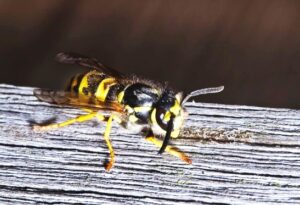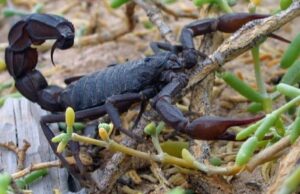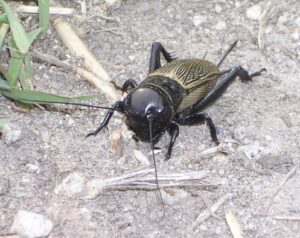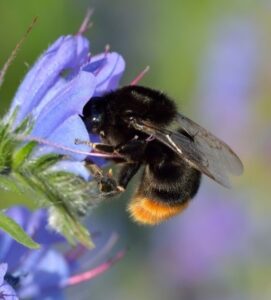German Yellowjacket or German Wasp
General Description
| · Yellowjackets are are sometimes mistakenly referred to as paper wasps because they build grey paper nests.· They are 1.3-1.5 cm long, black and yellow in color.
· The body is slightly wider than the head. |

Credit: pjt56 |
- There is a yellow band behind the compound eye.
- The face has three small black spots, and the antenna is long and black.
- The dorsal surface of the thorax is black with no stripes down the middle.
- The abdomen of the female has 6 segments and 7 segments in the male.
- The legs are yellow, and the wings are clear.
Life Cycle and Common Characteristics
- The queen emerges from hibernation and initiates a nest in the spring.
- The queen mates with up to 7 males.
- The colony grows rapidly during the summer (July and August) with an increase in worker numbers and nest size (more than 4,000 wasps, and more males than workers).
- The old queens die off in the fall and the colony collapses, and the new queen begins hibernation.
- The nests may survive through the winter and reach the next season.
- Yellowjackets are found in ponds, lakes, and swimming pools.
- They enter yards because they smell food (meats and sweets) or other attractants (pests attracting to grills and waste cans in outdoor picnics).
- Workers can be predators and scavengers.
- They are efficient at hunting for small, live food sources.
- As scavengers, they make many trips between the location of the nest and the food source.
Damages and Economic & Medical Implications
- The species is considered a public health threat in urban areas.
- Yellowjackets do not cause structural damage to homes. They may build nests in attics or walls and chew through drywall to enter living spaces.
- They defend themselves if disturbed.
- They are aggressive defenders of their colonies.
- They are not quick to sting, but their sting is painful. Each insect may sting several times.
- Stings induce severe allergic reactions.
- Severe pain or burning at the site lasts 1 to 2 hours.
- No deaths are attributed to yellowjackets.




